Disclaimer: This website contains affiliate links, from which Heritage Acres Market LLC may receive a small commission from the vendor on the sales of certain items, all at no cost to you. Please read our full disclosure for more information. Thank you for supporting Heritage Acres Market LLC!
Keeping backyard chickens is a fun and fulfilling pastime. Not only do you get the enjoyment of these wonderful birds, but you get lots of lovely fresh eggs too. To ensure our feathered friends stay in top health, they need feeding correctly. In this article, we will be discussing feeding poultry and asking, “what do chickens eat?”
The basics of chicken nutrition
- Chickens are omivores and can digest plants, seeds, and meat
- Grit helps chickens break down food since they don’t have teeth
- Chickens require a nutritent rich, balanced feed as their main source of daily rations even if they free range
- Chicken feed is sold in a variety of protein options, and as whole grain, pellets, crumbles, or mash
Table of Contents
What do Chickens Eat?
Chickens are omnivores, just like us. This means that naturally, they would eat seeds, plants, insects, earthworms, snails, small animals such as frogs, mice, and even some snakes.
They are also great opportunists, happy to peck at a carcass or forage grass seeds. Unfortunately, It’s this opportunistic nature that can backfire and turn them into egg eaters. I have witnessed a chicken lay an egg and mear moments later turn around and peck at it to get to the contents.
Luckily, chickens that eat eggs only tend to happen when there’s a food shortage or a lack of something in their diet. Because of this, regular feeding with good quality feed is so important. Once they have discovered how good eggs taste, it’s very difficult to stop the habit.
Many breeds of chicken enjoy being free-range and foraging for their food. It can be advantageous in helping to reduce feed costs. It also supplements the chicken’s diet with a wide variety of different things which are generally good for health.
Foraging is also the most natural way for chickens to eat. Getting food from a feeder is a lot less entertaining. Therefore, it is reasonable to suppose that it is also better for your chickens psychologically too. Even if allowed to free range, feed should always be made available to your flock.
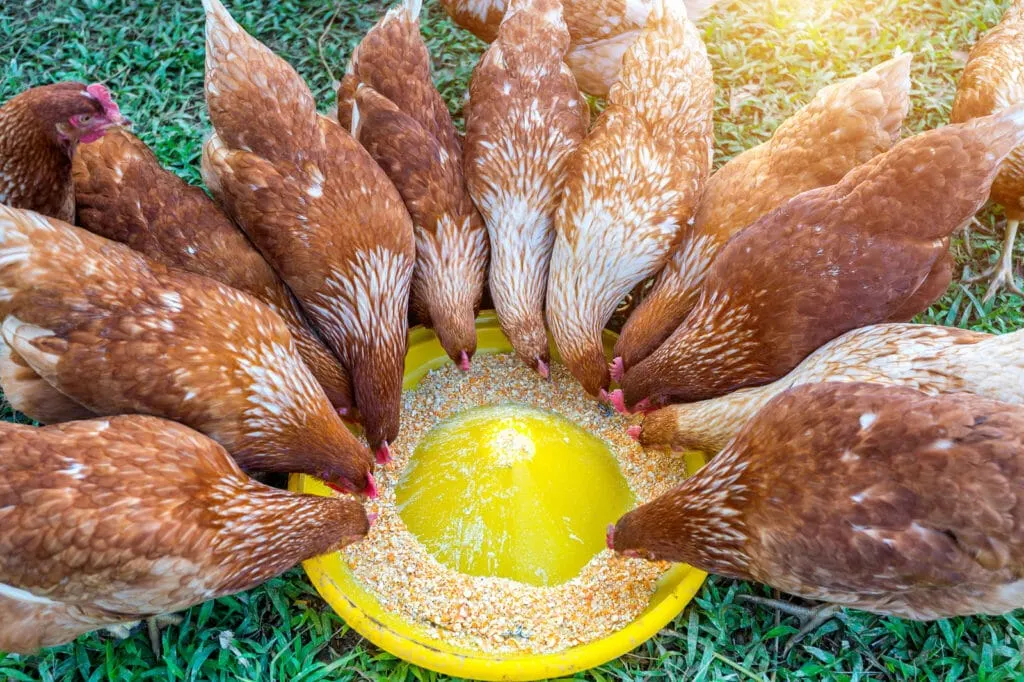
Grit
Although it has no actual nutritional value, insoluble grit is necessary to help chickens break down their food in the gizzard.
As chickens lack teeth, they have no natural way of grinding down their food, so they need a little extra help. A wild chicken would take up grit naturally as they pecked at insects, worms, and so on. The grit is stored in the gizzard and works like teeth to grind the food into a digestible mush.
The gizzard is a very tough but flexible kind of pouch made from muscle. The gizzard is where the food gets ground down as the muscle moves the food against the chips of stone. It’s rather like the grinding wheel of a mill.
Chicks
Chicks that are fed a commercial starter feed don’t usually need any grit. Chick feed is already small and can easily be digested without grinding. As chicks grow and are given kitchen scraps or mealworm treats, they will need grit. It is best not to feed chickens anything other than commercial feed until they are 3 to 4 months of age, as it can cause an imbalance in their diet.
If you give grit, you can use washed builders sand for chicks up to three weeks old. Very fine sand, such as that for kids play areas, is not coarse enough and can impact crops. After three weeks, you can buy chick grit with larger particles but is still finer than they will need as adults. Chick grit can be given until around two months of age when they move onto adult grit.
Adult Chickens
It is advisable to provide your birds with grit even if you only give them a commercial chicken feed.
Grit for adult birds is course, so make sure to get the correct grade from your feed store. If the grit is too fine, it won’t help them grind down the food and simply pass straight through them.
Some people think that free-range birds don’t need grit, as they can find stones in their environment. However, because you can’t know how much they are getting, it’s best to also provide them with grit as a supplement.
How to Feed Grit
Put a bowl of grit near their food. Keep it clean and replenish it as necessary.
Oyster Shell
Besides grit, the mineral calcium is required to build strong bones and form a hard egg shell. One of the best and easiest ways of providing calcium is by feeding your hens ground oyster shells as part of their diet.
Oyster shell is only needed by backyard hens that are laying or are just about to start laying eggs. Unlike grit, the oyster shell is soluble and dissolves in the gut.
Without sufficient calcium, a laying hen may have soft-shelled eggs, which can cause egg binding. Although commercial feeds do have calcium in them, it is not enough to fulfill the requirements for egg making.
As with grit, you can offer ground oyster shells in a bowl for your chickens to take as they want.
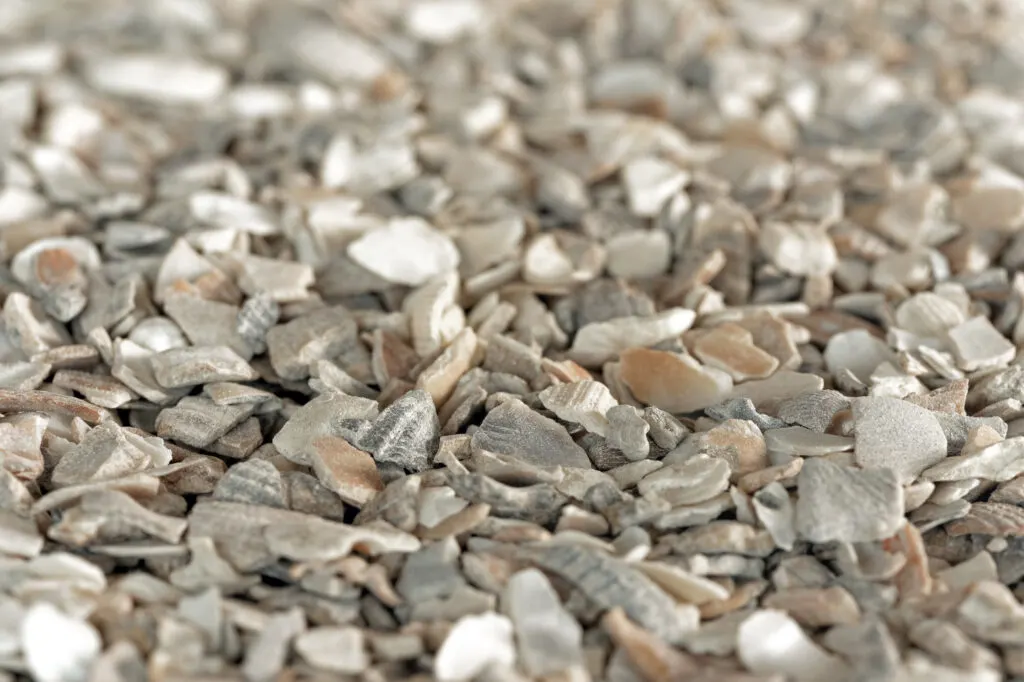
Essential Nutrition
Just as in a human diet, the key is variety and balance. Many chickens live their entire lives only being fed on ready-made commercial chicken feed. Commercial feed is a complete feed and carefully balanced by poultry nutrition experts to contain all the essential nutrients your chickens need. Different types of feed are made for various ages and purposes.
There are six components needed in a chickens diet, which are:
- Carbohydrate
- Protein
- Fat
- Vitamins
- Minerals
- Water
Just like other animals, a healthy chicken needs to eat to give them energy and to build and maintain a strong, healthy body as they grow and live. Without energy, they wouldn’t be able to function. Walking, eating, digesting, breathing, and keeping a stable temperature all demand nutrients.
Energy also allows for the development of skin, bone, feathers, and eggs. Without it, their health would become severely compromised.
Protein, carbohydrates, and fat can all be burned as energy sources because they contain carbon, hydrogen, and oxygen.
Protein and carbohydrates supply approximately 4 kcal of energy per gram. Fat can provide twice that, giving as much as 9 kcal per gram, which is why feed formulations need good sources of fat.
High-quality, nutrient-dense feeds provide more goodness in smaller quantities, so less feed is required to obtain the same, or better, results.
Let’s take a look at the six primary components of a chickens diet in more detail.

Protein
Protein is made up of small complex compounds called amino acids. It is broken down from the food the bird eats by the digestive system, and the amino acids are absorbed into the blood, where they can be transported to cells in the body.
The amino acids can be turned into specific proteins that the chicken requires to form muscle, skin, feathers, cartilage, nerves, and even egg white.
There are two types of protein amino acids, essential and nonessential. The essential amino acids cannot be made by the body and include lysine, histidine, leucine, phenylalanine, isoleucine, methionine, threonine, tryptophan, and valine.
The nonessential amino acids can be made by the body and include arginine, alanine, asparagine, cysteine, aspartic acid, glutamic acid, glycine, glutamine, proline, tyrosine, and serine.
A high-quality, correctly formulated commercial chicken feed should contain all of the essential amino acids required for your backyard flock, the two most important ones being lysine and methionine.
The most common protein sources in commercial feeds are soybean meal, corn gluten meal, canola meal, field peas, flax, lupins, sunflower seeds, insects, fishmeal, meat, and bone meal.
Carbohydrates
When quick energy is needed, Carbohydrates are the easiest way for the chicken to get it. They are also the preferred energy source by the cells of the body.
Carbohydrates are the most significant component of poultry feed. They are made up of different cereals such as wheat, corn, sorghum, millet, barley, and rye.
These can be either digestible or non-digestible carbohydrates. Digestible carbs’ Include starch and sugar, while indigestible ones are things like cellulose. You’ll find these listed as crude fiber on the feed label.
Fat
Fat is the most calorific substance by weight. Fats come in two different types, saturated and unsaturated. Solid at room temperature, saturated fats are derived primarily from animal fats for use in poultry feed. They could be lard or tallow.
Unsaturated fats can be monounsaturated or polyunsaturated and are liquid at room temperature. They come from vegetable oils, seeds, and nuts.
Some vitamins are only fat-soluble, so fat is required in the diet for them to be absorbed. Fat also helps to reduce the dust from grain and makes the feed more palatable.
One of the main problems with adding fats to feed is that it can cause the feed to become rancid (go bad), a particular issue in the summer. Feed producers often add antioxidants to help with this.
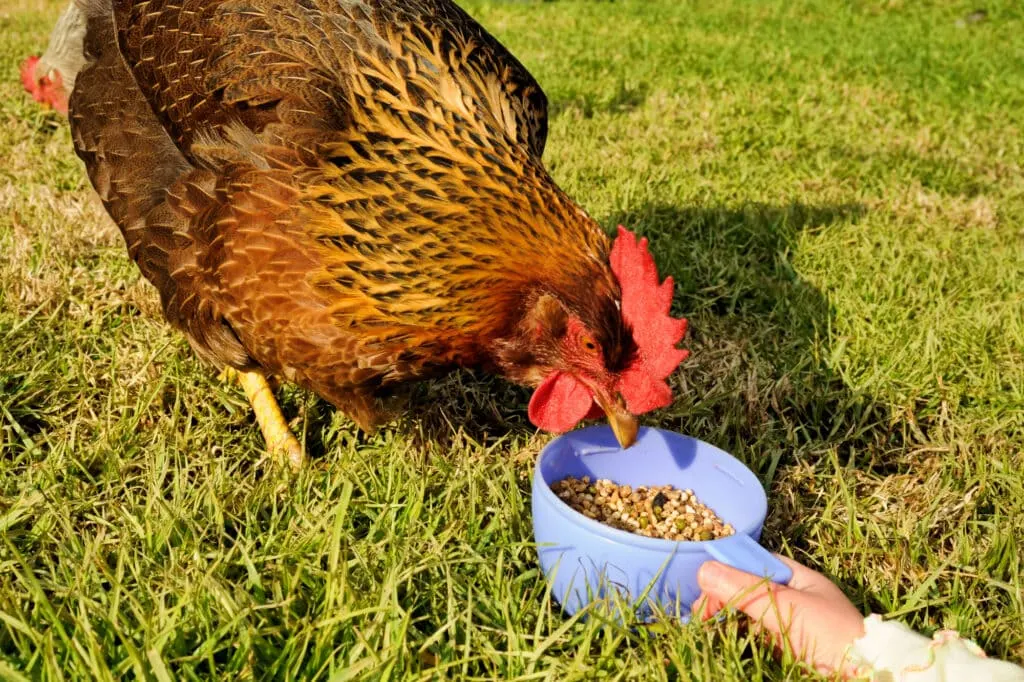
Vitamins
Chickens require vitamins in small quantities. These are organic compounds found in food needed for growth, reproduction, and normal body functions. Vitamin deficiencies can lead to many problems.
The fat-soluble vitamins are A, D, E, and K, while water-soluble vitamins are C and all the vitamin B’s.
Some vitamins, such as vitamin C, can be formed within the bird. Vitamin D can be synthesized from exposure to sunlight, but others must come from the diet.
Minerals
Like vitamins, minerals are only required in small amounts. They help with blood, metabolism, and muscle function.
Minerals are divided into two groups- macrominerals and microminerals.
Macrominerals include calcium, magnesium, phosphorus, chlorine, potassium, and sodium.
Calcium is of vital importance to egg-laying hens for them to lay eggs with a strong shell.
Microminerals include iron, copper, manganese, iodine, selenium, and zinc. Although the backyard chicken needs less of these than the macrominerals, they must still be contained in the diet.
Grains are typically low in minerals, so they are added to commercial feeds. It is also recommended to feed ground oyster shells as an addition to increase calcium uptake for layer birds.
Water
Clean, fresh water is essential for your chickens at all times.
Blood is made up of a large proportion of water. It carries essential nutrients from the digestive tract through to organs and cells. It also helps in the removal of waste. Not having water, even for a short period, can cause a reduction in the number of eggs and be detrimental to your bird’s health.
The best and easiest way to provide clean water to your flock is with chicken nipples. Chicken nipple waterers are unique in that they keep the water clean and free of dirt, debris, and algae. Their design also prevents the spread of disease, which is often transmitted in open waterers. Chicken nipple waterers are inexpensive, low maintenance, and are great for climates with freezing temperatures in the winter.
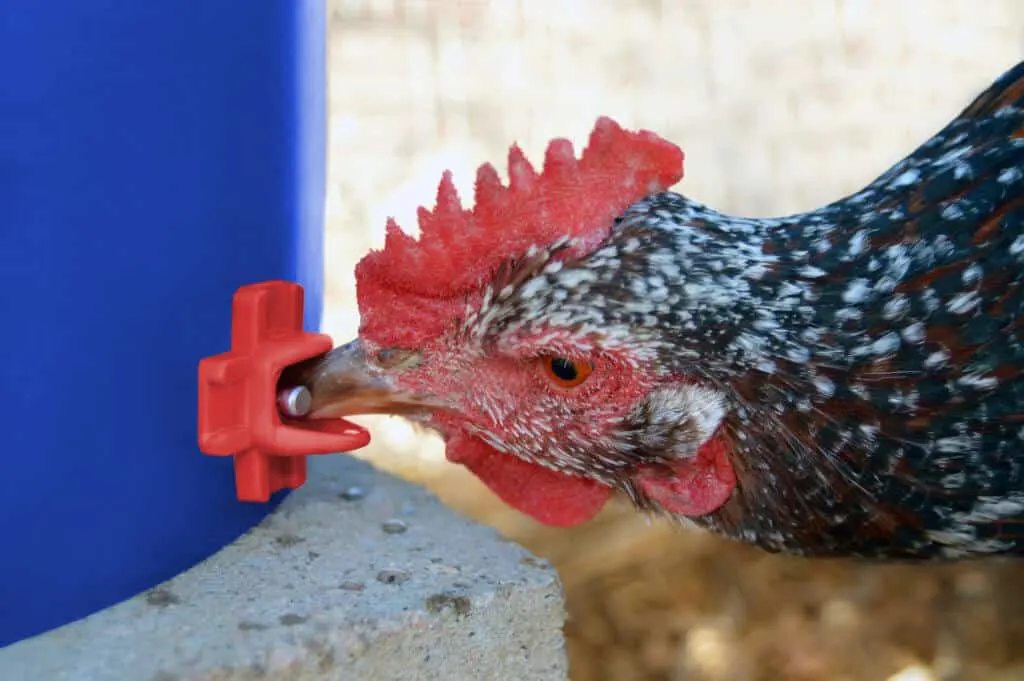
Different Types of Chicken Feed
To take the guesswork out of feeding chickens a complete and healthy diet, it is best to use a good quality commercial feed made for the type of birds you have. While it may be tempting to make your own DIY chicken feed, it can be difficult and expensive to create a mix that meets all of your chickens nutritional needs. High quality feeds such as Mile Four feeds meet all of your flocks needs.
A chickens feed requirements change according to age, the time of year, and general health. Commercial feeds are nutritionally balanced, and although they don’t require supplementation with anything other than oyster shell for laying hens, it is also advisable to offer grit to aid digestion. Some treats may also be offered to add variety and alleviate boredom.
There is a commercial chicken feed for every stage of a chicken’s life. They vary slightly depending on what brand you use. They typically include:
Chick Starter
Chick starter feed is fed to chickens from the time to hatch until they enter the next stage of their life, such as laying eggs.
For chickens that will become laying birds, the chick starter usually is around 20% protein. For meat birds, there is a broiler starter that has between 22% to 24% protein content.
Chick starter is sold as either medicated or unmedicated feed.
Medicated Feed
Mediated chick starter feeds are designed to help chicks build up an immunity to coccidiosis.
Coccidiosis (or cocci for short) is a parasite (protozoa) that can be found naturally in the dirt, and transmitted by the feces of adult chickens who were exposed to coccidiosis and are now immune. The coccidiosis parasite damages the gut wall in chickens and can be fatal. The most common symptom of coccidiosis infection is blood feces and sudden death.
Medicated chick starter feed has a low dose of Amprolium, a medication that disrupts and slows down the coccidiosis‘s ability to replicate once inside the chicks GI tract.
Should I feed my chickens medicated chick starter feed?
Coccidiosis can occur naturally in the soil. If you have ever had a confirmed case of coccidiosis in your flock, be sure to use medicated starter feed. You can also use medicated starter feed if you are unsure as two whether to not you may have coccidiosis in the soil.
For chicks being raised in a brooder, indoors and away from dirt or other chickens, feeding them medicated feed is ineffective. Chicks must be in contact with coccidiosis (or contaminated dirt) for the medicated feed to work.
While chicks are in the brooder, you can feed them unmedicated chick starter. However, if you are concerned about coccidiosis, be sure to switch them to a medicated chick starter a week or two before you move the chicks outside or before adding dirt to the brooder. Once you start feeding medicated chick starter feed, continue to do so until your birds are switched to a grower or layer feed.
Amprolium is a thiamine blocker, which means that chicks will not be able to absorb thiamine (vitamin B1) while being fed medicated chick starter. Keep in mind that the dose of amprolium is very low, and chicks could still become infected if there are high levels of coccidiosis in the environment.
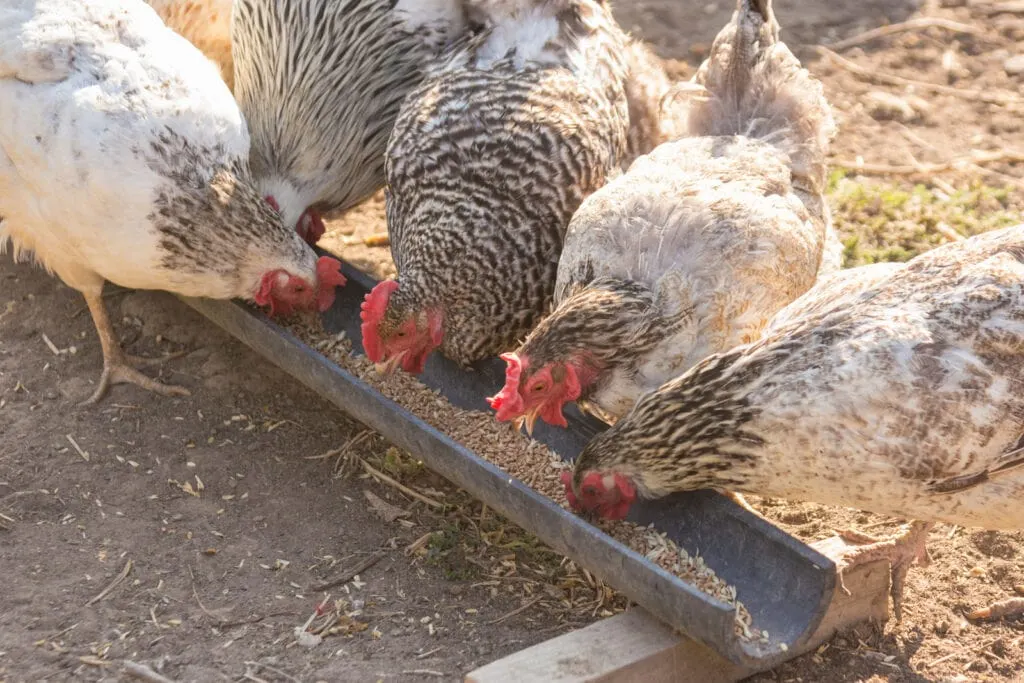
Layer Grower
Once your baby chickens reach six weeks, you can move them onto a layer or starter grower feed. Future laying hens grow slowly to produce strong bones and allow their internal organs to mature correctly. Feeding a product that is too high in protein can cause them to start laying too young.
If you are not able to find pullet grower feed, don’t worry. Most people feed their birds a chick starter feed until they are about 6 months old or start laying. If pullet grower is not available in your area, continue to use chick starter.
Broilers and meat birds like Cornish chickens are fed a broiler grower feed, which has a higher protein content, typically 18%.
Layer Developer/Finisher
By 14 weeks of age, layer pullets can be put onto a 16% protein layer feed until they begin to lay. Some feed brands don’t have a separate grower and finisher feed and simply combine it into one stage.
Layer Feed
Most breeds of laying hen mature in around 20 to 22 weeks. At this age, they need a 16% to 18% protein feed that has added calcium and minerals. Layer feed ensures hens lay eggs with good strong shells.
Feeding layer feed to young birds can cause kidney damage, so don’t switch your chickens to layer feed until they are about 20 weeks old or once they start laying eggs. Roosters can also be fed layer feed.
Broiler Feed
Meat birds grow fast and need a much higher protein feed than layer birds. Typically the broiler grower-finisher feed is between 18% to 20% protein. Heritage birds, or those that free-range, can be given a lower protein feed of 16% after 12 weeks of age.
Feather Fixer Feed
Feather Fixer feed has been designed to feed birds when they go through a molt, usually in the fall. It helps them grow strong, healthy feathers and helps maintain hard eggshells. It can, however, be fed at any time of year.
All Flock Feed
All flock feed is designed for a mixed flock that includes not only chickens but other birds like ducks or turkeys. It is usually around 17% to 18% protein and is also suitable as a turkey finisher.
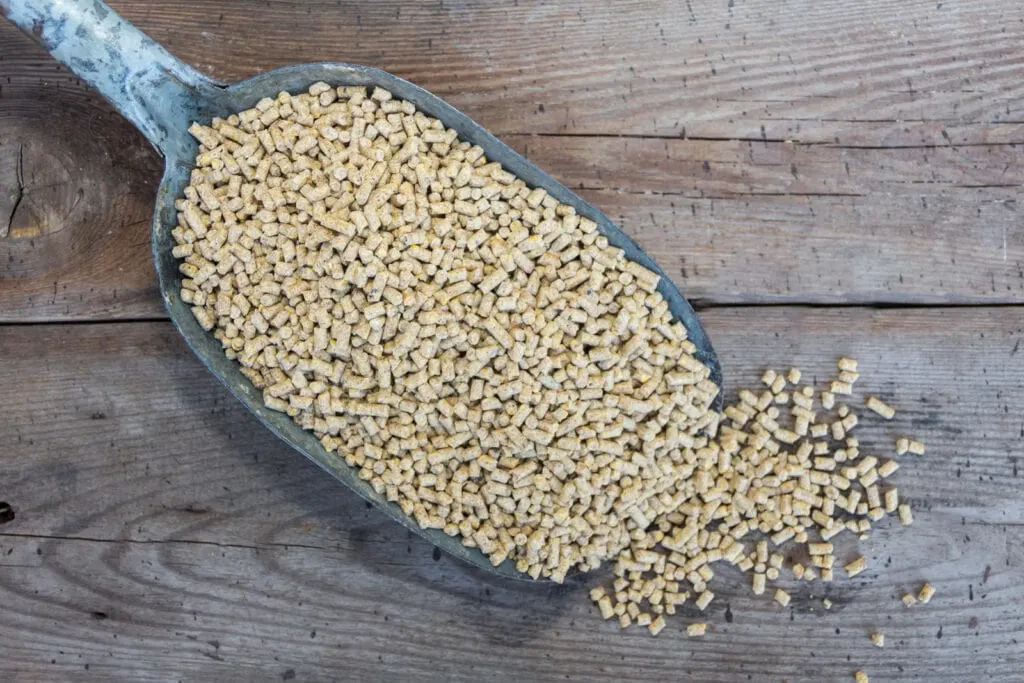
Scratch Grain
Scratch grain is not intended to be a primary food source, but rather a treat. By nature, chickens scratch at the ground looking for seeds, insects, grit, and greens. This behavior is encouraged by giving them some scratch grain comprising a mixture of grains and seeds like cracked corn, wheat, barley, or oats.
Scratch grain is usually a low protein, high-energy food and is akin to candy or fast food for a chicken. Because commercial feeds are carefully formulated, giving too much scratch grain is likely to upset the balance.
Only provide scratch grain occasionally and think of the 90:10 rule, 90% commercial feed, 10% other food. Grit must also be provided when feeding scratch grain, as it is essential to aid digestion.
Pellets vs Crumbles vs Mash
Commercial feeds are sold in three forms: pellets, crumbles, and mash. This simply refers to the size of the feed.
Pellets are the largest size of feed, and are shaped like compact cylinders. Crumbles are smaller and look like broken pellets. Mash is the smallest, and is a loose and finely ground form of chicken feed.
Pellets, crumbles, and mash are all nutritionally equal. Think of it like an apple- whether you eat the apple whole (pellets), cut it into slices (crumbles), or chop it up (mash), it’s still an apple.
Typically, chicks and young birds are fed mash and crumble since these are smaller and easier to eat. Adult birds can be fed mash, crumbles, or pellets.
Whole grain feed is another form of chicken feed, but it is less common. Whole grain feed is made of cracked grain and unprocessed ingredients. Unlike pellets, crumbles, and mash, in whole grain feed you can see all of the ingredients.
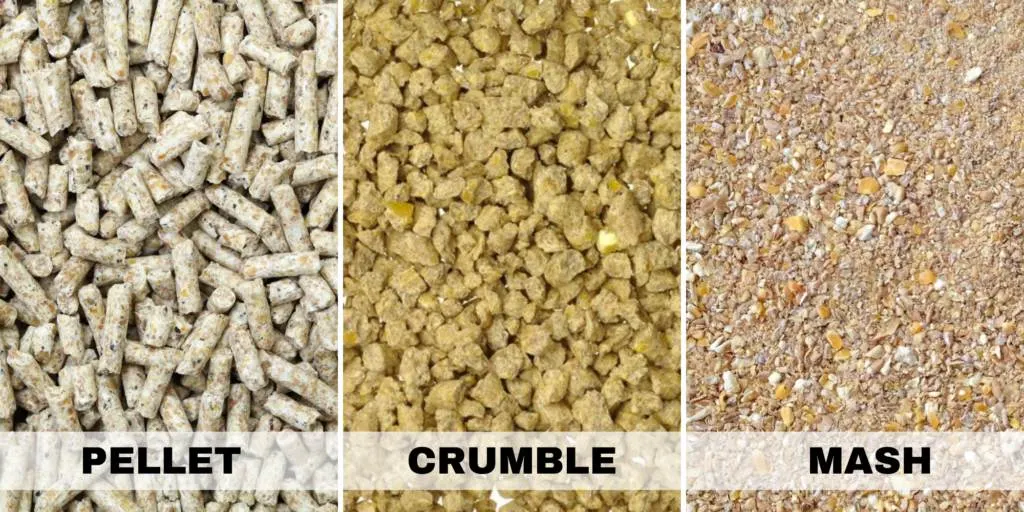
Speciality Feeds
You can find a number of specialty chicken feeds, including organic, soy-free, corn-free, and non-GMO. These types of feed will cost more than the average bag of commercial chicken feed.
Organic chicken feed contains no pesticides. Just like organic food at the supermarket, organic chicken feed is made from grains that were not treated with pesticides.
Soy-free and corn-free feeds are great for chicken keepers with a soy or corn allergy or sensitivity. Some people are allergic to store-bought eggs because commercial laying hens are fed a corn and soy diet. Feeding chickens a soy-free and/or corn-free diet may allow these folks to be able to eat eggs.
Non-GMO chicken feed is made with grains that are not genetically modified. GMO stands for Genetically Modified Organism. Basically, GMO plants are those that have had their DNA altered by scientists. If you would like to learn more about Genetically Modified Organisms, please visit this site.
Keep in mind that these specialty feeds are sold in different proteins and forms as explained in “Different Types of Chicken Feeds” above. For example, you can find layer feed that is available as an organic crumble.
Fermented Chicken Feed
You may have heard of fermented chicken feed. Fermented chicken feed is not a type of feed that can be purchased, rather it is an optional at home process to make chicken feed healthier and last longer.
In short, fermenting chicken feed is feed that has been soaked in water for 2-3 days. This soaking process causes the feed to absorb water and then start to ferment, which adds probiotics and makes the feed easier to digest.
All types of chicken feed can be fermented, and it’s a great way to save money and improve the health of your flock. You can read more about fermenting chicken feed here.
Treats For Chickens
While chicken feed is a complete nutrient source, many people enjoy giving their chicken treats. Some common treats include:
- Mealworms (learn how to raise mealworms here)
- Grubblies
- Black oil sunflower seeds
- Kitchen scraps
- Scratch grain
Kitchen scraps
Many people feed their backyard chickens their kitchen scraps, and this is fine, providing you are careful about what you give. Some chicken treats could become prove fatal. A comprehensive list of what chickens can and can’t eat can be found here.
Some notes to keep in the forefront of your mind; do NOT feed chickens Avocado, particularly the pit and the peel, which has the potential to be fatal. Chocolate, uncooked potatoes, and in particular green potatoes or their skins/peelings, dried or uncooked beans (fully cooked baked beans are fine in small amounts), broad beans, moldy or rotten food, and highly processed food must also be avoided.
Giving excessive amounts of table scraps, particularly those with a low nutritional value, such as lettuce or bread, can reduce egg production. Only feed chickens enough kitchen scraps that can be eaten within 15 to 20 minutes.
Rotten scraps, or those with mold on them, may cause botulism which is deadly.
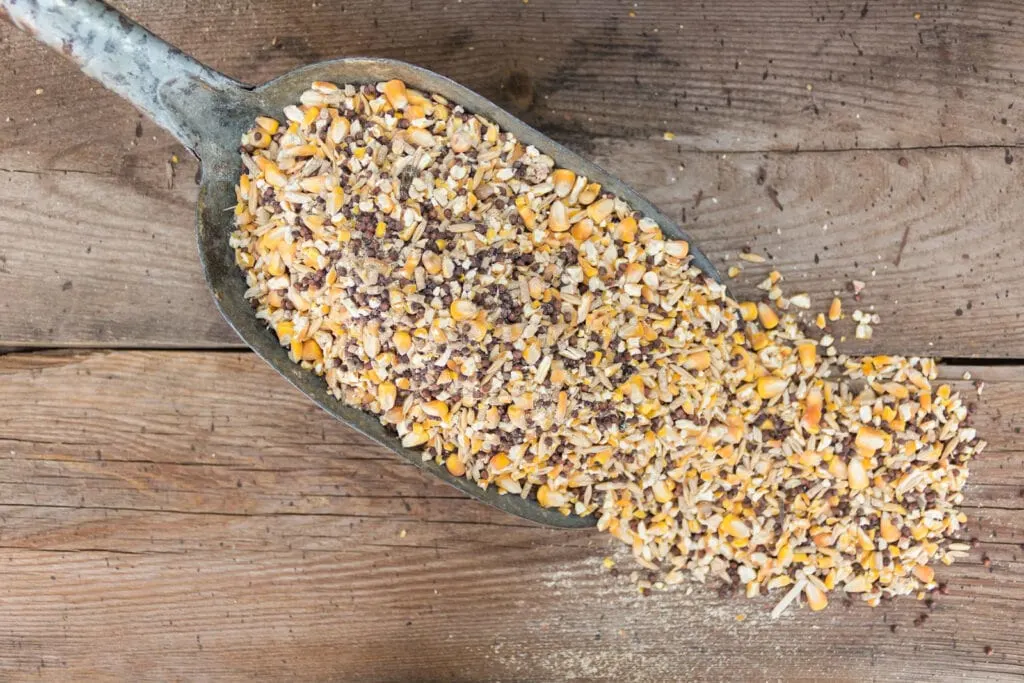
How Much to Feed Your Chickens
The amount of food you feed your chickens will depend on their age and the food you provide.
As a rough guide, you would need to provide approximately ¼ pounds of food per day for each bird, or about one and a half pounds of food per day for six adult chickens.
How To Feed Chickens
The easiest way to feed chickens is with a treadle feeder. A treadle feeder is a large capacity feeder that uses a step activated door that gives chickens access to the feed. Treadle feeders are the best feeder for chickens because they keep rodents and wild birds out of the chicken feed, and protect the feed from rain and snow.
Having a large capacity feeder means you won’t need to fill it up as often, and it allows chickens to eat as much food as they need.
In general, chicken feed should be provided in a feeder or dish, and not tossed on the ground. Feeding chickens off the ground increases the chances of spreading disease because the feed is likely to become contaminated with chicken feces.
When hanging a suspended feeder, place it so that the feed level is the same height as the chickens back. This prevents the birds from scratching at the feed and should also help stop rodents from accessing it.
Placing feeders in a small space or against a wall can mean more timid chickens don’t get enough to eat.
Avoid placing your feed in the chicken coop itself. Leave it outside in the chicken run or where they free range. This is to stop rodents from entering the hen house.
It is also best to remove the food at night, as chickens don’t eat after dark, a prime time for rodents to feast.
Wild birds may spread disease to your flock. For that reason, it’s best to try and keep them out of your chicken pen and away from the feed.
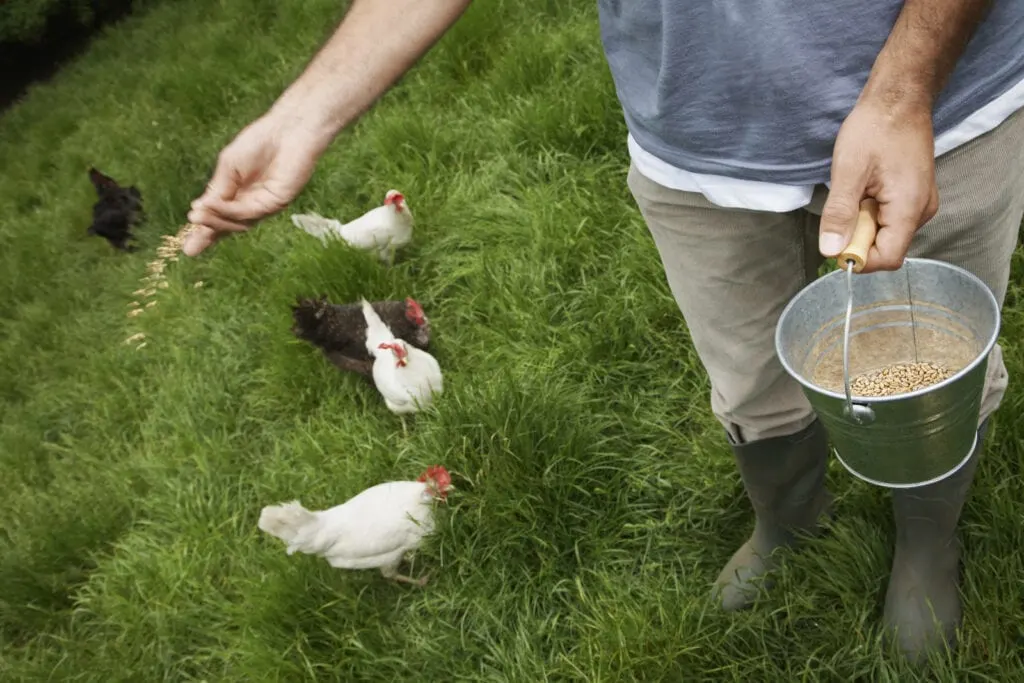
Storing Chicken Feed
Chicken feed should be stored in a dry location, and kept in a sealed container to prevent contamination by rodents or insects.
Many feed bags are not waterproof, and should not be left outside in the rain. Never feed moldy feed to chickens.
The easiest storage for chicken feed is a metal trash can. Metal trash cans are weather resistant and can’t be chewed through by hungry rodents. You can usually fit two 50 pound bags or three 40 pound bags of feed in one can.
Conclusion
Chickens require a well balanced, nutrient-rich diet to stay healthy and thrive. If they aren’t provided with the proper nutrition, then issues will inevitably occur. This could be illness, egg problems, or a failure to develop properly.
Although it’s possible to make your own chicken feed, it is safer and more practical to use a commercial one. These are balanced for your chickens needs depending on their age and function.
Chickens love treats, but they can cause an imbalance in their nutritional requirement if fed too many. It is best to limit them to a maximum of only 10%.

ContinueRight.com
Tuesday 19th of March 2024
A very excellent site and your information is very valuable. We, as experts in this field, appreciate your efforts. Thank you and continue to provide more.
Donna
Tuesday 31st of January 2023
Thank you your information was very helpful.